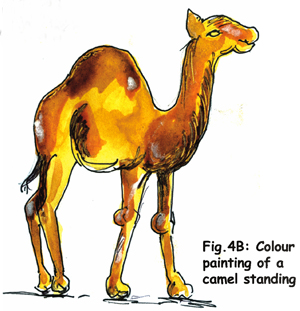|
[Learn to draw]
By Tissa Hewavitarane
How to draw and paint
A camel
  Before
starting to draw and paint a camel, children should know its history,
biology and life span. This is only a short account of the camel's life
mostly in the desert. These animals are mainly found in the Middle East
countries where they are fed and looked after by the royal families in
the Middle East. Before
starting to draw and paint a camel, children should know its history,
biology and life span. This is only a short account of the camel's life
mostly in the desert. These animals are mainly found in the Middle East
countries where they are fed and looked after by the royal families in
the Middle East.
The camels are used for royal functions and sports. Arabs in the
Middle East countries conduct camel races. The camel's anatomy bear
clear fatty deposits known as "humps" on their back. Camels provide
milk, meat, hair for textiles or goods such as felted pouches and
working animals.
The average life-span of a camel is 40-50 years. A full grown camel's
height is 1.85 m (6 ft 1 inch) at the hump. Camels can run up to 65 km
(40 mph) in short bursts and sustain speed up to 40 km (25 mph). The
camel is tall and has long legs.
Fig. 1 shows you the basic outline drawn with a thin pointed pencil.
It shows a seated camel taking a rest.
Fig. 2 shows a complete body structure of the seated camel from a
side view.
Fig. 3 shows a complete colour painting of a camel seated. At first a
light yellow ochore is applied on the body. Next a mixture of burnt
sienna is applied to get the shading effect.
  The
hump is shown with yellow ochore and mixed with a little brown. Usually
a camel's skin is brownish in colour. To finish the painting a thin
outline is drawn with a thin nibbed pen dipped in black ink or with a
pointed No. 1 brush. The
hump is shown with yellow ochore and mixed with a little brown. Usually
a camel's skin is brownish in colour. To finish the painting a thin
outline is drawn with a thin nibbed pen dipped in black ink or with a
pointed No. 1 brush.
Fig. 4 shows the basic outline of a camel standing. The whole body
structure can be seen with long legs, ears and the most noticeable the
hump.
Notice the first sketch does not show a hump because it is the
beginning of the sketch.
The second sketch shows a more advanced outline drawing. As the camel
skin looks yellow ochore the correct skin colour is a mixture of yellow
ochore and brown.
The colour is strengthened with a dark shading of brown. The drawing
paper used is Kent 180 gsm and brushes soft Sabel hair Nos. 1,3 and 6. |

